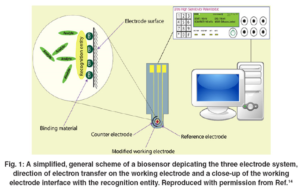The Use of Electrochemical Biosensors in Food Analysis
- Rapid and precise analytical tools are essential for monitoring food safety and screening of any undesirable contaminants, allergens, or pathogens, which may cause significant health risks upon consumption. Substantial developments in analytical techniques have empowered the analyses and quantitation of these contaminants. However, conventional techniques are limited by delayed analysis times, expensive and laborious sample preparation, and the necessity for highly-trained workers. Therefore, prompt advances in electrochemical biosensors have supported significant gains in quantitative detection and screening of food contaminants and showed incredible potential as a means of defying such limitations.
- Biosensor attributes
- A biosensor can be defined as an analytical device that combines a biologically sensitive recognition element (such as antibodies, nucleic acids, enzymes, organelles, whole cells and aptamers) immobilized on a physicochemical transducer, and connected to a detector to identify the presence of one or more specific analytes, their concentrations, and kinetics in a sample. Electrochemical biosensors use an electrode transducer to detect electrons released by the reaction of the bioreceptor and analyte to obtain a measurable analysis of the contaminant. Figure 1 shows the general scheme of a biosensor.

Key to the operative success of biosensors is their biological recognition elements which imparts a superior level of specificity and binding affinity with the target molecule. Such binding is termed specific binding or coupling and determines if an interaction occurs, which creates the electrical signal that is recorded and amplified. Because of the particularity of the recognition entity toward the analyte, a high level of selectivity is achieved which results in signals generated solely from such precise interactions, irrespective of the matrix complexity. This is terrifically illustrated by, commercially available, glucose meters that exploit a working electrode modified with glucose oxidase ensuring that a response is solely derived by glucose.
The demand for high-speed, accurate and selective identification of analyzes present within food produce, such as pathogenic bacteria, pesticides and toxins, has facilitated rapid advances in biosensor development and enabled quantitative detection and screening. Apart from their inherent specificity, these biosensors help address the multifactorial food industry challenge of high analytical accuracy in the midst of the complex food matrices, overcoming differing densities, pH and temperature. It has been argued that for biosensor use to become widespread, they need to offer further substantial benefits over existing methods. One such advance is the potential for sensor miniaturization, which results in the sensor requiring greatly reduced sample sizes or volumes. However, sensor miniaturization has only partially been achieved to date due to limitations in the structural integrity of very fine electrode tips associated with microelectrodes.
The recent development of novel bio-recognition molecules, such as synthetic aptamers, DNA, proteins and viruses has enabled considerable selectivity in analysis. Furthermore, parallel improvements in the immobilization of bio-recognition molecules through robust attachment methods like electrodeposition and nanoparticle-bound entities at the working electrode interface is a significant step in the increased application of biosensors in food analysis. This is due in no small part to their greater specificity, selectivity and affinity for their target analytes.

Leave a Reply